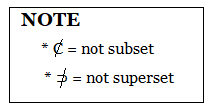A set is a collection of well defined or pre-decided. Hi friends, in today’s article we are going to know about the different types of sets in mathematics or economics. So let’s discuss in details.
Types of Sets
The different types of sets in mathematics or economics are explained in the following ground –
• Empty set or Null Set – A set is said to be empty set which has no element. In other words, a set which has no element is called empty set or null set. It is denoted by the symbol φ (phi).
As for example – A set of natural number which is less than one (1).
• Non empty Set – A set which at least one element is called or known as non-empty set. As for example – A = {0}
• Unit set or Singleton Set – A set which has only one element is called or known as unit set or singleton set. As for example – A {0}
• Universal Set – The universal set is defined as that set which include the total of elements under consideration as elements of any set. As for example –
E = {Tossing of a coin}
= {Head, Tail}
Again,
E = {Throwing an unbiased die}
= {1, 2, 3, 4, 5, 6}
• Finite Set – A set is said to be finite set whose elements can be count. In other words, a set which has finite number of element is called a finite set. As for example – A set of whole number which is less than 10 (ten).
A = {0, 1, 2, 3, 4, 5, 6, 7, 8, 9}
• Infinite Set – A set whose elements can not be count is known as infinite set. As for example – A set of all starts in the sky.
• Disjoint Set – If any two or more sets do not have any common elements then they are called disjoint set. As for example –
A = {a, b, c, d}
B = {1, 2, 3, 4}
∴ A and B represents disjoint set.
• Overlapping Set – The common elements between two or more sets as it overlaps to one another is known as overlapping set. As for example –
A = {2, 3, 4, 5}
B = {2, 6, 3, 8}
C = {9, 2, 3, 7}
Hence, A, B and C are the overlapping set because they consists of common elements 2 and 3.
• Equal Set – Two sets are said to be equal set when the following two conditions are satisfied –
(i) There should be same number of element in two set.
(ii) There should be same elements in two set.
As for example of equal set –
A = {1, 2, 3, 4, 5}
B = {1, 2, 3, 4, 5}
Here, n(A) = 5 and
n(B) = 5
∴ A = B
• Equivalent Set – Two sets are said to be equivalent set if and only if both the sets have same number of element but not necessary to same. It is denoted with the symbol ‘≡’ (‘≡’ = Equivalent) . As for example –
A = {1, 2 , 3, 4, 5}
B = (a, b, c, d, e}
n(A) = 5
n(B) = 5
∴ A ≡ B
• Subset – Let A and B are two sets. If every elements of A is an element of B then A is called a subset of B and we write A⊂B (A subset B). As for example –
B = {0, 1, 2, 3, 4, 5}
A = {1, 2, 3}
Here, A⊂B
Or B⊃A (B Superset of A)
• Power Set – The set of all subset of a given set A is called or known as the power set of A and it is denoted by P(A). As for example –
If A = {1, 2, 3}
P(A) = 2n = 2³ = 8
Then,
P(A) = {φ {1}, {2}, {3}, {1, 2}, {1, 3}, {2, 3}, {1, 2, 3}}
P(A) = 2n
n(A) = 8
• Complement of a Set – The complement of a set is defined as a set which consist of such elements which are included in universal set but not included in the given set.
In other words, if U is a universal set and A is subset of U then the complement of A is the set which contains those elements of U which are not included in A and its denoted by A1 or Ac or AA.
Let,
U = {1, 2, 3, 4, 5, 6, 7, 8, 9}
A = {2, 3, 6, 7}
∴ Ac = {1, 4, 5, 8, 9}
• Union of Set – The union of a set is defined as such set which consists or contains all the elements in the given sets by avoiding duplicate elements. As for example –
A = {1, 2, 3, 4}
B = {3, 4, 5, 6}
A∪B = {1, 2, 3, 4, 5, 6}
A = {x| 3 ≤ x ≤ 10}
B = {x| 7 ≤ x ≤ 20}
A∪B = {x| 3 ≤ x ≤ 20}
• Intersection of a Set – Intersection of a set is defined as such a set which contains only the common element in the given sets. The intersection of two sets A and B, written as A∩B. As for example –
A = {1, 2, 3, 4}
B = {1, 3, 5, 2}
∴ A∩B = {1, 2, 3}
• Deference of Set – The difference of the sets is defined as the set, elements which belongs to first set but not the second set. As for example –
A = {2, 3, 4, 5}
B = {2, 4, 9, 6}
A – B = {3, 5}
A – B = {9, 6}
Conclusion
So friends, this was the different types of sets. Hope you get the full details about it and hope you like this article.
If you like this article, share it with your friends and turn on the website Bell icon, so don’t miss any articles in the near future. Because we are bringing you such helpful articles every day. If you have any doubt about this article, you can comment us. Thank You!
Read More Article


